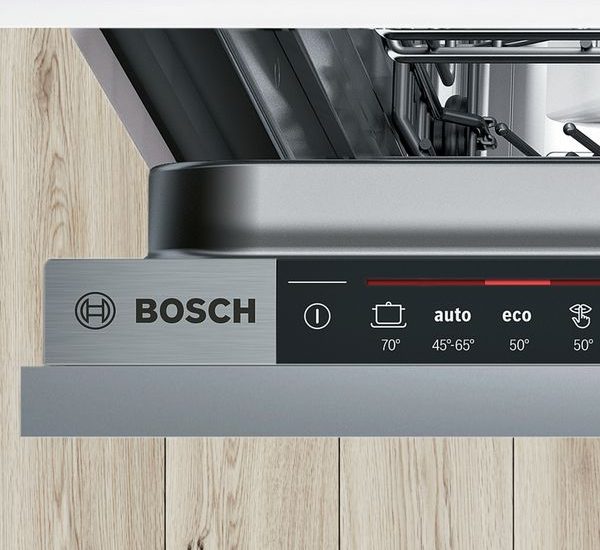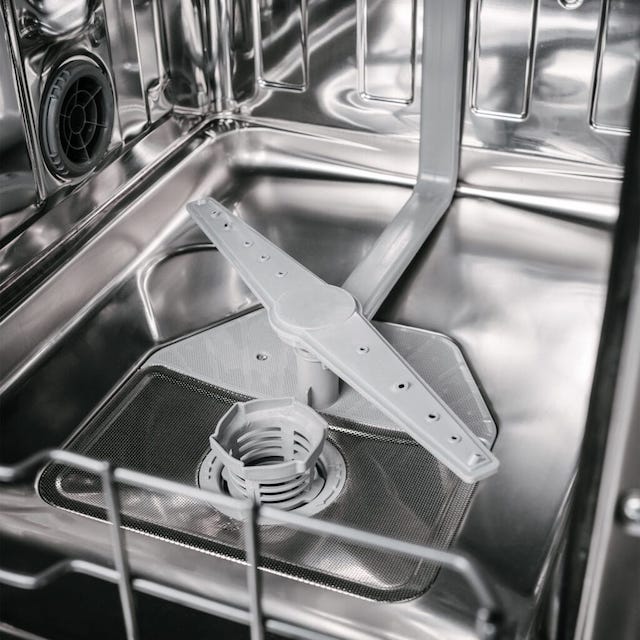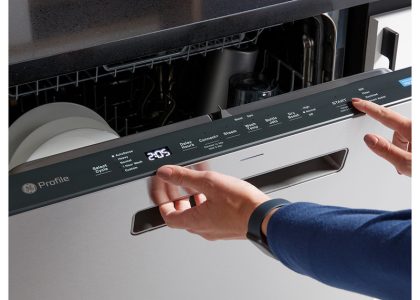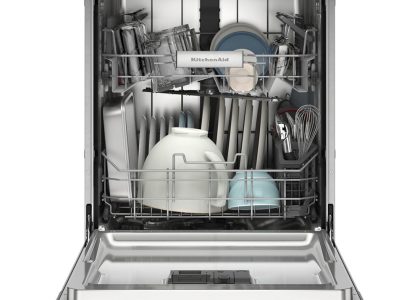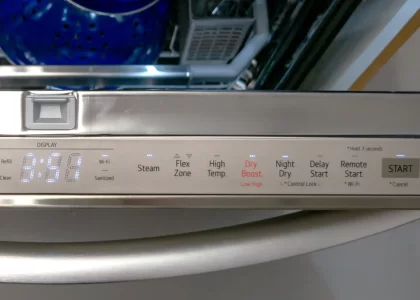Understanding Dishwasher Energy Use
Understanding the energy consumption of your dishwasher is key to managing household costs. Do you ever wonder how many watts does a dishwasher use? Knowing this number helps you estimate the overall power costs. Dishwashers vary in their wattage based on design and function. Energy use changes with different washing cycles and features. The wattage of a dishwasher contributes to the cost of running it. All these aspects can affect your utility bill. It’s important to consider the energy impact when you choose a dishwasher. In the next sections, we’ll explore what affects a dishwasher’s energy use and provide tips for efficiency. We will also look at which models use less power. Remember, a lower wattage dishwasher often means lower energy consumption. This can lead to savings in your energy expenses over time.
Average Wattage of Dishwashers
When considering how many watts a dishwasher uses, the average comes into play. Most household dishwashers use between 1200 to 1500 watts. To put this into perspective, it’s similar to running a hairdryer or a microwave. However, keep in mind this is just the average range. Some models can dip as low as 800 watts. Others peak at around 1800 watts, especially if they have advanced features. Models with high wattage often boast faster or more intense wash cycles.
It’s important to check the specific wattage of your dishwasher model. This can usually be found in the owner’s manual or on the manufacturer’s website. Knowing your appliance’s exact wattage allows for more precise cost estimations. For instance, using a dishwasher with a wattage of 1500, four times a week, can add up over time. But it’s not just about the wattage. Other factors also play a critical role in determining energy usage. In the following sections, we’ll delve deeper into these factors and how you can control them to save energy.
Factors Influencing Dishwasher Energy Consumption
Several factors can impact how many watts a dishwasher uses. Understanding these will help you make smart choices and cut down on energy costs. Here are the main factors to consider:
- Cycle Type: Dishwashers come with different cycle types, like normal, eco, and intense. Each cycle uses different amounts of energy.
- Age of the Dishwasher: Newer models are often more energy-efficient. Older dishwashers may use more power.
- Load Size: A full load uses energy more efficiently than washing just a few items at a time.
- Dishwasher Features: Some features, such as heated dry or soil sensors, can increase energy use.
- Installation and Maintenance: Proper installation and regular maintenance ensure your dishwasher runs efficiently.
- User Behavior: The way you load the dishwasher and your choice of cycle can affect wattage used.
By paying attention to these factors, you can optimize your dishwasher’s energy use. This can lead to significant savings on your electric bill over time. Next, we’ll provide you with some practical tips to reduce the energy your dishwasher consumes.
Tips for Reducing Dishwasher Energy Usage
To cut back on dishwasher energy use, adopt these easy and effective tips:
- Select Eco-Friendly Cycles: Choose the eco or energy-saving cycle. It uses less water and energy.
- Wash Full Loads: Always run your dishwasher with a full load. This maximizes energy efficiency.
- Air Dry Dishes: Skip the heated drying cycle. Instead, crack open the dishwasher door to air dry dishes.
- Maintain Regularly: Clean the dishwasher’s filter and check for lime buildup. This keeps it running smoothly.
- Load Smartly: Place dishes in a way that water spray reaches all of them. This avoids re-washing.
- Cool Washes: Avoid using high-temperature wash settings, which consume more energy.
- Install Properly: Ensure your dishwasher is installed in a location that doesn’t strain its efficiency.
Implementing these strategies can help reduce the energy your dishwasher consumes. Watch your energy bills go down as you use these energy-saving methods.
Energy-Efficient Dishwasher Models
When shopping for a new dishwasher, look for energy-efficient models. These dishwashers are designed to use less power while still providing clean dishes. They often have wattages that are lower than the average range of 1200 to 1500 watts. Let’s consider some specifics to keep in mind:
- Energy Star Rating: Choose dishwashers with an Energy Star label. This means they meet energy efficiency guidelines set by the EPA.
- Wash Cycle Options: Models with various cycle options can save energy. For example, an “auto” cycle can adjust water use based on how dirty your dishes are.
- Delayed Start Feature: This lets you run the dishwasher during off-peak energy hours. It can cut down on your electricity bill.
- Soil Sensor Technology: Advanced sensors detect dirt levels. They adjust the cycle to use just the right amount of water and energy.
Opt for a dishwasher that balances performance with energy conservation. Even if they cost more upfront, they pay off over time. They lower your bills and reduce your carbon footprint. It’s a win-win for both your wallet and the environment.
The Relationship Between Dishwasher Cycles and Energy Consumption
The energy a dishwasher uses varies with each cycle. ‘How many watts does a dishwasher use?’ is not a one-size-fits-all answer. Different cycles are designed for different purposes, and each has its own energy footprint. Let’s break down the typical cycles:
- Normal Cycle: This is the standard cycle for everyday dishes. It uses average energy.
- Eco Cycle: Eco-friendly option uses less energy and water. Ideal for lightly soiled dishes.
- Intense Cycle: For heavily soiled items, uses more energy for thorough cleaning.
- Quick Wash: Saves time but might not be energy-efficient due to high power use over a short period.
- Auto Cycle: Adjusts energy use based on how dirty the dishes are, generally energy-efficient.
Choosing the right cycle can impact your dishwasher’s wattage use significantly. For example, using the eco cycle can save energy compared to a normal cycle. This means lower power bills. Always evaluate the degree of soiling on your dishes to select the most appropriate cycle. A dishwasher running on an eco cycle uses fewer watts than one on an intense cleaning cycle.
In summary, your choice of cycle determines how many watts your dishwasher uses. By picking the most suitable cycle, you can control your energy use and cost. Remember to opt for full loads and eco cycles to conserve energy. Small changes in your dishwashing habits can lead to noticeable savings on your electricity bill.
The Impact of Water Heating on Dishwasher Energy Use
Water heating is a major factor in how many watts a dishwasher uses. Most dishwashers heat their own water. The higher the water temperature, the more energy you will use. Dishwashers with built-in heaters can use more energy during wash cycles. This is because they heat water to the optimal temperature for cleaning.
However, you can manage this energy use. Many dishwashers allow you to control the water temperature settings. Opt for lower temperatures if possible. Warm water can clean dishes effectively and uses less energy than hot water. Some models even have ‘eco’ modes that wash at lower temperatures. These modes significantly cut down energy consumption.
Using hot water from your home’s water heater can also impact energy use. If your dishwasher draws in hot water, it uses less electricity for the machine to operate. Make sure your home water heater is energy-efficient. This can further reduce your dishwasher’s overall electricity consumption. Consider setting your water heater to a lower setting. Also, insulate hot water pipes to prevent heat loss as water travels to your dishwasher.
Remember, reducing the water temperature can lower how many watts a dishwasher uses. It’s an easy change that can lead to savings on your energy bill. Always check the manual for the recommended settings. This ensures optimal performance without unnecessary energy use.
Reading Your Energy Label: Estimating Dishwasher Power Costs
Understanding how many watts your dishwasher uses is pivotal for estimating power costs. Your dishwasher’s energy label is your best friend here. It contains vital information about the appliance’s energy consumption. Reading it lets you make informed decisions. It helps in understanding the expenses tied to operating your dishwasher. Each label displays the average wattage used during a standard wash cycle.
The numbers on the label can guide you to calculate the cost of each cycle. To estimate the cost, you’ll need the wattage, your electricity rate, and cycle time. Multiply the wattage by the duration of the cycle in hours. Then, multiply that number by your electricity rate per kilowatt-hour. The result is the cost of running that cycle.
For example, if your dishwasher uses 1200 watts, and a cycle takes 1 hour, with an electricity rate of $0.12 per kilowatt-hour, the cost per cycle would be $0.144. Over time, these costs add up. By knowing this, you can better manage your energy budget.
Remember, an Energy Star label means the dishwasher meets strict energy efficiency criteria. These models can save you money on your electric bills. Look for this label when shopping for a new appliance.
Finally, make it a habit to refer to your energy label. It helps in predicting monthly expenses and encourages energy-saving habits. With this knowledge, you can tweak the way you use your dishwasher to lower those costs. Every watt counts when it comes to saving on your energy bill.

